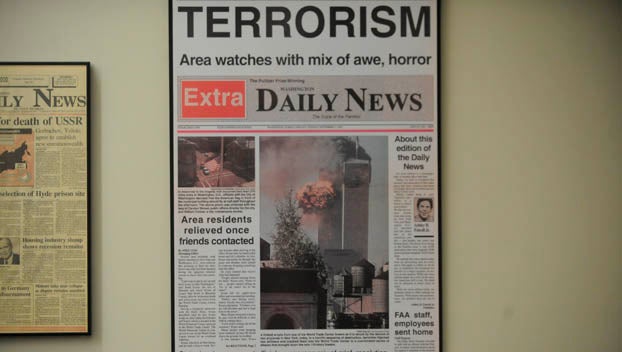‘America has been cut deeply’: Inside the newsroom on 9/11
Published 7:19 pm Friday, September 10, 2021

- Sept. 11, 2001 marked the first and only day this newspaper has produced an extra section. It included a mix of local and national reaction to the attacks. (Brandon Tester / Washington Daily News)
|
Getting your Trinity Audio player ready...
|
Sitting in a meeting at Beaufort County Community College, Brownie Futrell, then publisher of the Washington Daily News, began jotting down a brief editorial that would appear on the cover of the first and only extra edition the newspaper has ever published.
“Today, we hurt to recapture the security and innocence of that other place and time,” his column reads in part. “America has been cut deeply, the scars of which are not likely to heal soon.”
Several hours earlier, Futrell’s wife woke him up early and told him to turn on the news. He still remembers vividly the footage that came across his screen: a plume of smoke coming from the North Tower of the World Trade Center complex, which had been hit by a hijacked airplane shortly before he woke up; and shortly after that, the harrowing sight of a second airplane crashing into the South Tower.
As those events unfolded, it became clearer that it wasn’t by accident; America was under attack.
The answers to whom, what and why were unknown, but the significance of what happened on the morning of Sept. 11, 2001 was immediately evident. So when he walked in to the BCCC Foundation Board meeting that day, Futrell gathered his thoughts, wrote his column and outlined a special section that would go out later that day.
“I knew that the newspaper needed to do something, both from a news standpoint but also from a comfort standpoint in the community,” Futrell said, looking back on that day 20 years later. “It’s kind of a reassuring agent that even though our country is under attack, that our resolve was greater than any challenge that would be placed in front of us.”
An extra edition, as Futrell wrote on that day, is “a newspaper relic of another place and time.” But that morning’s events called for one, and he shared his plans when he returned to the newsroom, which joined the rest of the country in a collective state of shock.
“We had never printed an extra. Not when Pearl Harbor was attacked, not when John Kennedy was assassinated, not when the space shuttle exploded,” Futrell said. None of those.
“But this was an event of such significance, certainly in my lifetime, that I felt like it merited an extra edition. So we said we’re going to publish a newspaper this afternoon. It’s not going to have any ads in it, because this is not a marketing attempt; this is not something that we want to do to create revenue. This is something we want to do in service.”
The special section included a combination of local reaction and stories from the wire. The front page featured two prominent pictures: an Associated Press photo of a fireball bursting from one of the towers after it was hit, and an image of the American flag in front of the Washington municipal building flying at half-staff.
Mike Voss wrote about local residents who checked in with their family members in New York and Washington, D.C. following the attacks; and Jonathan Clayborne shared the reactions of state and local government officials. In addition to Futrell’s piece, which included a reaction to the attacks as well as an explanation of the special edition, the front page also included an update about the Federal Aviation Administration’s actions following the attacks.
“We printed several thousand copies,” Futrell said. “We divided the city of Washington into territories, and we had every employee, regardless of what department they were in, take several neighborhoods and go door to door and deliver these papers, with no regard for whether a person was a subscriber or not. That was not the point.
“People could watch on TV in real time what was happening. So that was not what we were trying to replace, because the electronic medium was certainly more visible and more immediate. Ours was more of a calm reassurance that we were all in this together, and we all had something to give.”
The special section was well received.
“There was no political motive, there was no monetary motive,” Futrell said. “It was what we could give back. And that was the point — we all had something that we could give back, and it was up to all of us to search ourselves to see what it was that we had, individually and collectively, to give back. And so the response was tremendous, more so than anything else that I was ever a part of during the time I was here.”
The shock and horror of the 9/11 attacks will always stand out to Futrell and others who witnessed them. But the feeling of unity as the country recovered from that tragedy stands out as well.
“I just hope that at this 20th anniversary, people remember the feelings of togetherness and the feelings of patriotism and the feelings of one resolve that we had in the aftermath in 9/11, and maybe try to recapture some of that feeling in a time like we’re in today where things are so polarized, especially politically.”





